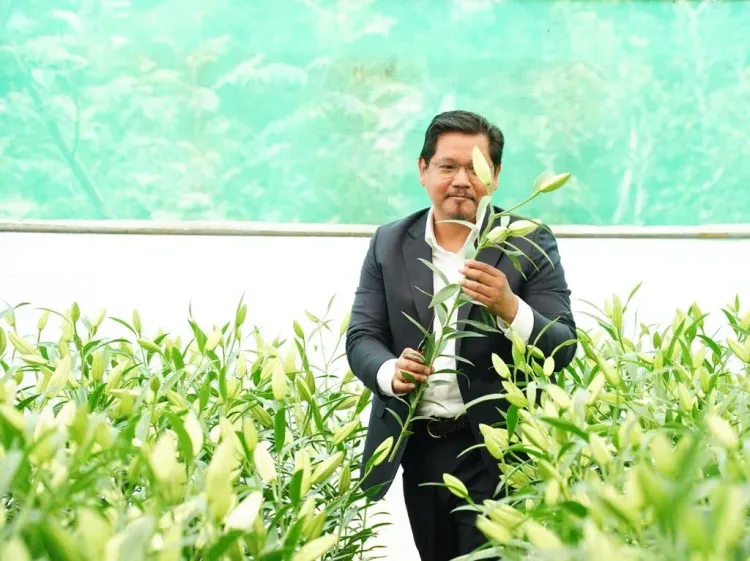Is Meghalaya's Rs 240 Crore Floriculture Mission the Future of Farming?

Synopsis
Key Takeaways
- Rs 240 crore investment to enhance floriculture.
- Targets over 3,000 farmers with subsidies and training.
- Focus on high-demand flower varieties like Orchids.
- Partnerships with expert providers for quality assurance.
- Aligns with broader agricultural strategies for sustainable growth.
Shillong, Aug 5 (NationPress) Meghalaya's Chief Minister Conrad K. Sangma revealed a groundbreaking investment of Rs 240 crore for the next three years through Floriculture Mission 1.0, a key initiative aimed at establishing the state as a premier center for high-value flower farming in the Northeast and throughout India.
During a visit to Mawkriah village in the East Khasi Hills district, Sangma, along with Agriculture Minister Ampareen Lyngdoh and local MLA Ronnie Lyngdoh, highlighted the mission’s ability to create sustainable, climate-resilient income opportunities for countless farmers.
“This marks the largest investment in floriculture in Meghalaya’s history,” the Chief Minister asserted.
“Our goal is to enhance livelihoods and generate direct profits of Rs 600 crore through this initiative in the upcoming years.”
Launched in March 2024, the Floriculture Mission aims to reach over 3,000 farmers, providing a subsidy package of Rs 7 lakh for each beneficiary. This support encompasses inputs, greenhouse infrastructure, and specialized training.
Nearly 500 farmers have already joined and begun to reap the benefits of the program. The initiative will focus on cultivating premium flower varieties, including Orchids (Dendrobium, Cymbidium, Vanda, and Phalaenopsis) and Oriental Lilium, which are highly sought after both at home and abroad.
Meghalaya’s unique mix of tropical and temperate climates provides an ideal setting for growing these high-value crops.
To ensure quality production and market readiness, the government has partnered with two expert service providers - Darjeeling Gardens and North Bengal Floritech, who will supply premium planting materials, offer technical support, and ensure market access under a three-year buyback agreement.
“We are implementing scientific cultivation techniques to develop flower clusters tailored to our region,” Sangma remarked. “We are integrating innovation with the natural advantages of our state.”
The Floriculture Mission is part of the state's larger agricultural strategy, which has already shown success with programs like the Lakadong Turmeric Mission, where production increased from 1,000 MT to over 20,000 MT. These achievements have been propelled by strategic investments, SHG-led value addition, and robust market connections.
“Our agricultural vision is straightforward - harness local strengths, scale them effectively, and empower farmers to diversify and double their incomes,” the Chief Minister added.
“We aim to make agriculture a cornerstone of sustainable economic development.”
To nurture the floriculture sector's growth, the government also plans to create dedicated storage and logistics centers in key production areas. These hubs will enable timely transport, maintain flower quality, and ease market access for producers.
Sangma noted that initiatives like CM’s Farm Plus, CM-Assure, and others will be synchronized with the floriculture mission to provide comprehensive support to farmers statewide.









